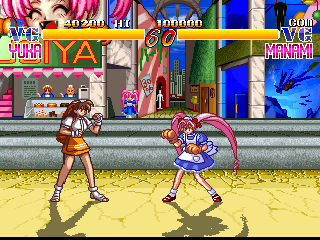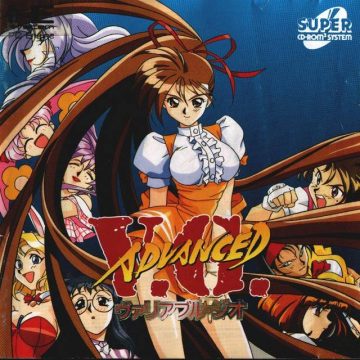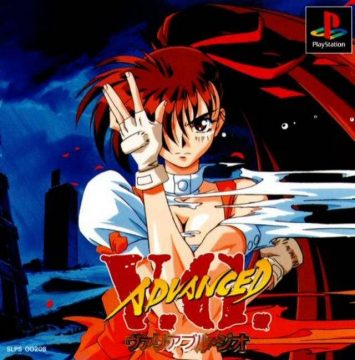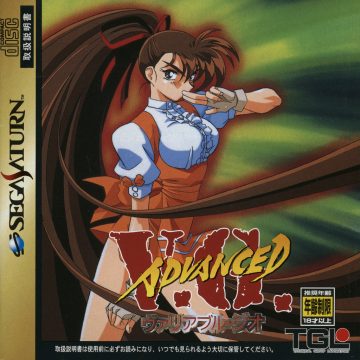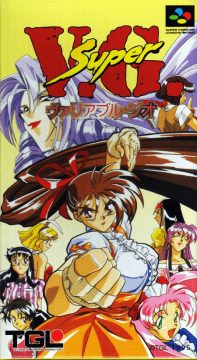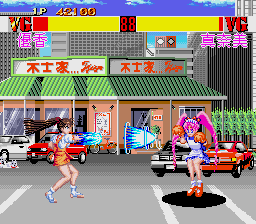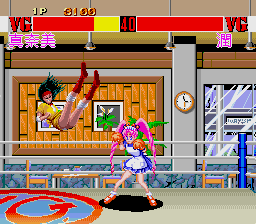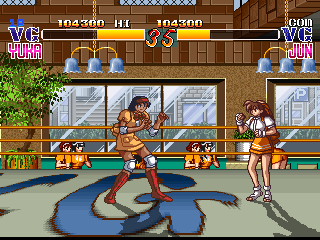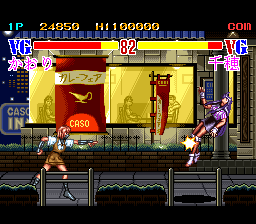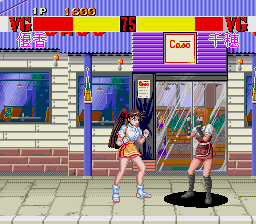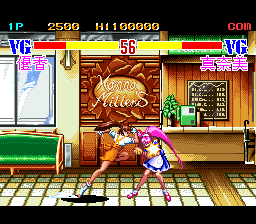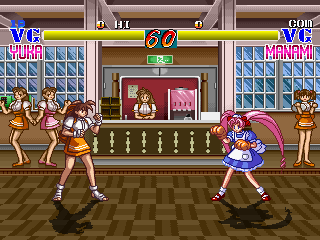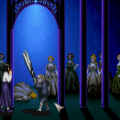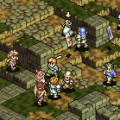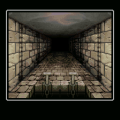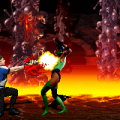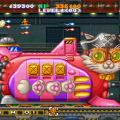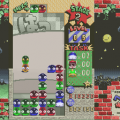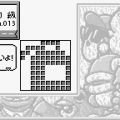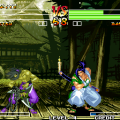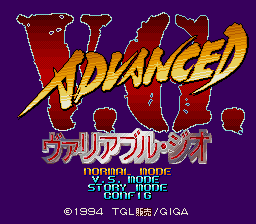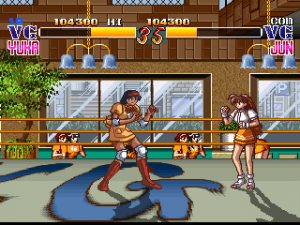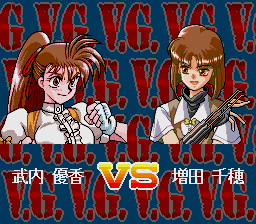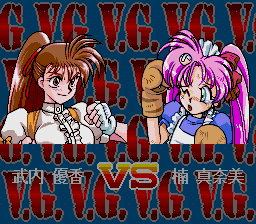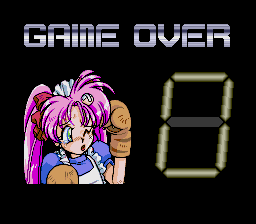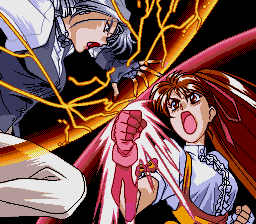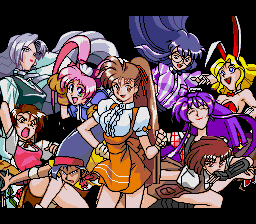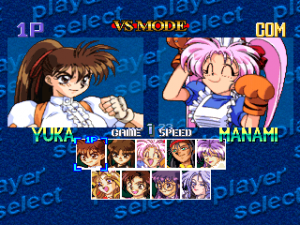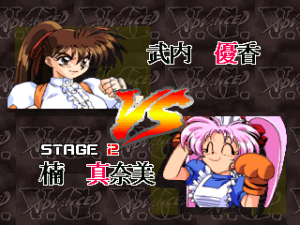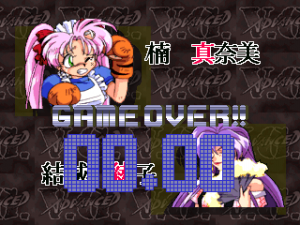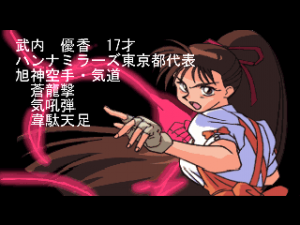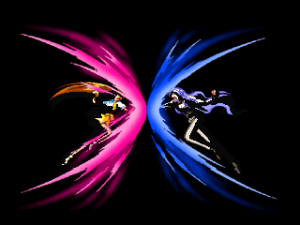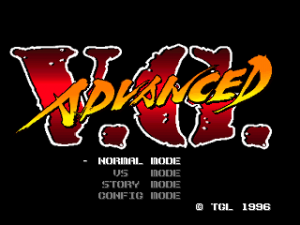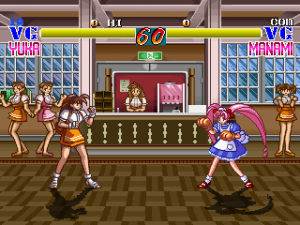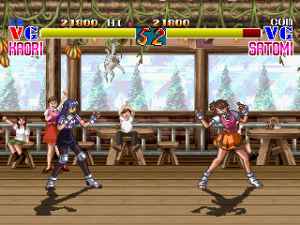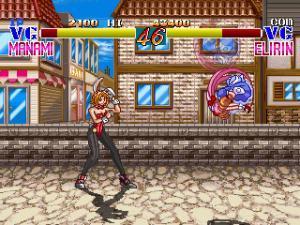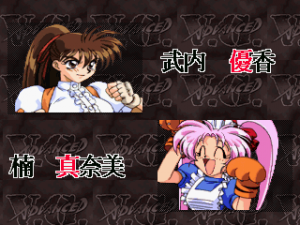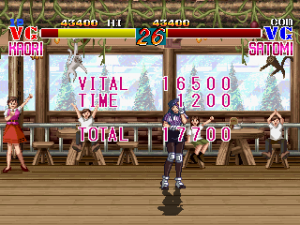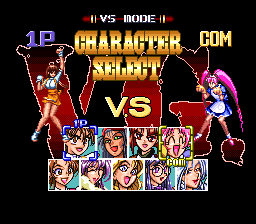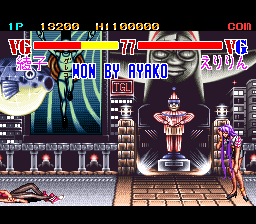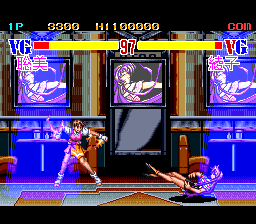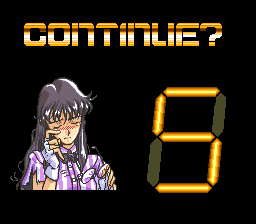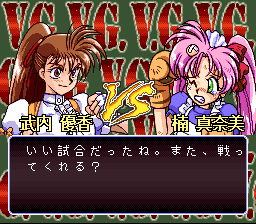- Variable Geo
- Advanced Variable Geo
- Variable Geo II: The Bout of Cabalistic Goddess
- Advanced Variable Geo 2
Variable Geo certainly wasn’t a good fighting game. Like many adult games, it primarily existed to show off its naked female contestants, with the quality of the fighting action coming in at a distant second, not to mention the inherent ropiness of PC98 action games. Such games have a limited audience to their content, but the publishers must’ve felt the series had mass market appeal. Which is why later on the game underwent a reboot on various console systems as Advanced V.G., with questionable content heavily toned down or removed altogether, depending on the platform, making the V.G. series accessible to more players.
The gameplay of Advanced V.G. games is closer to Capcom’s flagship fighting franchise than PC98 entries were, with a little bit of Fatal Fury thrown in for good measure. There are now heavy and light varieties to basic punches and kicks and, as per classic fighter fashion, each character comes with their unique abilities and combos. The Fatal Fury part comes with the “desperation attacks” – once the energy meter starts flashing red, the player can perform a usually powerful attack that might even the odds or outright beat the opponent before they get you first (this mechanic is not present in the PC Engine CD version though).
This time around there are three modes of play. The Normal game is your standard-arcade style sequence of bouts against every single playable opponent until the ending, specific for each gal. Between the fights, there are short dialogues, which are voiced in Japanese only and without any subtitles. Then there’s the Versus .ode that allows you to play a single match against a second player, CPU or just watch CPU fighters duke it out. Finally, as opposed to PC-98 entries, Advanced V.G. comes with the Story Mode, in which you unveil the tale of the protagonist, Yuka Takeuchi, during the course of several duels, culminating in a confrontation against the boss character and an outro. The story follows a different continuity since this is a reboot that has nothing to do with previous games. Once again, Takahiro Kimura returned to his role as the character designer, whose artworks make the cutscenes attractive as always, with known names in the seyiuu community providing the voiceovers this time around.
Characters
Yuka Takeuchi
The main character of the story. A waitress at Hanna Miller’s restaurant, she’s also a practitioner of Kyokushin-style karate. Yuka entered the tournament solely to prove herself as a martial artist. She’s pretty much the game’s equivalent to SF2‘s Ryu, right down to her moveset. Voiced by Yukana Nogami.
Chiho Masuda
A kunoichi waitress of the Masuda clan, Chiho participates in V.G. to win the fortune and run away from her family and her duties as a ninja. Voiced by Hekiru Shiina (PCE, PS1, SFC) and Yoko Asada (Saturn).
Manami Kusunoki
A happy-go-lucky idol singer/catgirl/maid who neither doesn’t know anything about martial arts nor has supernatural powers and solely relies on her mobility and Neko Rocket Punch gloves. Almost a joke character, she’s the hardest to play as, since her moveset revolves around hit-and-run tactics. Voiced by Kae Araki.
Jun Kubota
A former Olympic wrestler who was banned from participating in that competition after severely injuring her opponent, which earned her a “Bonebreaker” nickname. She turned to V.G. to vent her aggression and show the world that she’s the strongest woman. Basically Zangief of the game, but prettier. Voiced by Chiharu Tezuka.
Ayako Yuuki
Ayako owns the SoTo dance club and is an avid rave dancer herself, which is apparent in her fighting style. Every single attack of hers has something to do with dancing, even her idle animation is that. Voiced by Yuri Amano.
Erina “Elirin” Goldsmith
The only non-Japanese character in the roster, Erina was born and raised in Japan, bullied throughout her childhood by the Japanese kids for being a foreigner. Thus she developed some street fighting techniques of her own. Also a walking stereotype of an American woman as seen by the Japanese, right down to the Playboy bunny costume. Voiced by Miyuki Matsushita.
Satomi Yajima
Yuka’s friend and rival from the dojo, Satomi entered the competition in hopes of making money for a living and taking care of her severely ill brother after their parents died in a car accident. She can manipulate fire though her arms somehow. Voiced by Chisa Yokoyama.
Kaori Yanase
A computer geek who works at the MoHiKan cafe and the runner-up to the title of V.G. champion, repeatedly defeated by Reimi. She possesses knowledge on every other V.G. fighter which she uses to her advantage. Kaori is a practitioner of taekwondo fighting style, so she uses almost only kicks. Voiced by Yuri Shiratori.
Reimi Jahana
The reigning and undisputed champion of the tournament and CEO of Jahana Group, the company behind the whole tournament. Reimi is just as dangerous as she is pretty. Voiced by Kumiko Watanabe.
The first release of Advanced V.G. was in 1994 for the PC Engine Super CD. It looks somewhat similar to the PC98 original, but both sprites and backgrounds are more colorful now. It runs much smoother though, but characters’ sprites and movement animations are still on the clumsier side and don’t do justice to Kimura’s artworks. Controlling the action can be quite weird if you’re using the standard two-button controller: a single tap executes a weak punch or kick, while holding a button performs the stronger attack. The opponent AI is also not the best – on the lower difficulty settings it feels like fighting a punching bag, whereas on the higher ones the CPU tends to be input-reading. The soundtrack is in redbook format this time around, featuring arranged songs from the first game as well as new ones, and the quality is pretty good. The same can’t be said about audio effects though, which still sound rough around the edges. Overall, the PCE version feels more like a straightforward port, albeit explicit stuff is replaced with ecchi (lots of ladies’ panties in your face, that is) and features an expanded character roster with three new waitresses, who also appeared in n the PC98 sequel V.G. II (Ayako, Elirin and Satomi).
An improved iteration of Advanced V.G. appeared in 1996 for the Sony PlayStation and in 1997 for the Sega Saturn. Both seem to be almost identical in appearance, with smooth on-screen action, new sprites redrawn from scratch and prettier backgrounds when compared with the PCE version. The sound effects are also improved in quality since the 32-bit systems have better audio capabilities, especially when it comes to voice samples that were awful in the initial release. Exclusive to the Saturn edition is the option to display humiliation scenes after winning a fight, which are still censored compared to the PC98 original. Other than that, both releases are pretty tame when it comes to adult stuff, with girls’ busted clothes being the only bit of fanservice – no gratuitous panty shots this time around.
Meanwhile, the game was released for the Super Famicom in 1995 as Super V.G., one year before the PlayStation port. It’s the stripped-down version of the PCE game, yet visually it resembles the later iterations. The sprites are obviously less detailed to fit the technical limitations of the SFC and voice acting has been reduced to girls’ in-game speech. The Story Mode is gone altogether, along with boss characters, making Reimi the final opponent. The AI of the CPU-controlled opponents seems to be just as cheap as in the PCE version. It’s also the only game in the series to appear on a cartridge-based system.
All the Variable Geo games with the Advanced moniker were released under the Technical Group Laboratory (TGL) label to differentiate them from the adult-oriented titles for personal computers. In 2009, the PS1 game was made available on the PS3 and PSP via the PlayStation Network service. A version for the NEC’s PC-FX system was in the works, but it was eventually scrapped due to console’s untimely discontinuation.
With the fighting game craze going on at the time in Japan (and worldwide, for that matter), it was expected of big franchises of the genre to have their anime adaptations. Both Street Fighter II and Fatal Fury received those, and surprisingly, despite not being as big as those two series, Variable Geo has a three-episode OVA loosely based both on the PC-98 version and its console derivatives, which appeared on home video between 1996 and 1997. It’s not really that much of a good watch, with inconsistent story and lots of filler scenes. There’s also a good portion of torn clothes or even occasional nudity, but nothing as naughty as in the original game. At least fight scenes are cool enough with most of the special techniques present and the character designs are true to the source material. Despite the games never leaving Japan, there is an English dub of this OVA, but as expected for a 1990s release of an unknown property, its quality is below average.
All in all, there’s little reason in playing Advanced V.G. other than the novelty of being an all-female Street Fighter II clone, and it’s not even alone in that regards, especially with the superior Asuka 120% series. It is indeed decent enough and definitely better than the PC-98 ones, but why bother when other titles in the genre do the same job just as good if not better? Unless you really need those anime girls, then getting Advanced Variable Geo is not really recommended. Still, this specific entry in the series gained a cult following in Japan, mostly due to the character designs. The PlayStation-exclusive sequel, however, is on a whole new level.
Screenshot Comparisons
